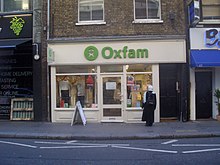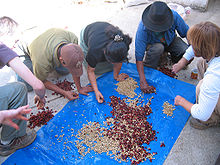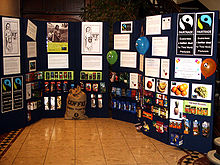Fair trade
The first attempts to commercialize fair trade goods in markets in the global north were initiated in the 1940s and 1950s by religious groups and various politically oriented non-governmental organizations (NGOs).Fair trade during that period was often seen as a political gesture against neo-imperialism: radical student movements began targeting multinational corporations, and concerns emerged that traditional business models were fundamentally flawed.[14] By 1968, the Whole Earth Catalog was connecting thousands of specialized merchants, artisans, and scientists directly with consumers who were interested in supporting independent producers, with the goal of bypassing corporate retail and department stores.The Whole Earth Catalog sought to balance the international free market by allowing direct purchasing of goods produced primarily in the U.S. and Canada but also in Central and South America.Moreover, several fair trade supporters were worried by the effect on small farmers of structural reforms in the agricultural sector as well as the fall in commodity prices.Although buoyed by growing sales, fair trade had been generally confined to small worldshops scattered across Europe and, to a lesser extent, North America.The independent certification allowed the goods to be sold outside the worldshops and into the mainstream, reaching a larger consumer segment and boosting fair trade sales significantly.The labeling initiative also allowed customers and distributors alike to track the origin of the goods to confirm that the products were really benefiting the producers at the end of the supply chain.The goals were to improve the visibility of the Mark on supermarket shelves, facilitate cross border trade, and simplify procedures for both producers and importers."[28] ATOs have fair trade at the core of their mission and activities, using it as a development tool to support disadvantaged producers and to reduce poverty[29] and combining their marketing with awareness-raising and campaigning.According to EFTA, the defining characteristic of ATOs is equal partnership and respect–partnership between the developing region producers and importers, shops, labelling organizations, and consumers.The Fairtrade certification also attempts to promote long-term business relationships between buyers and sellers, crop pre-financing, and greater transparency throughout the supply chain.These farmers cited switching to organic farming, wanting to raise money for social projects, and more training offered as reasons for joining the cooperative, other than receiving a better price for their coffee.Thirty-eight percent of producer-groups spend the social premium in its entirety on themselves, but the rest invest in public goods, like paying for teachers' salaries, providing a community health care clinic, and improving infrastructure, such as bringing in electricity and bettering roads.For example, Costa Rican coffee cooperative Coocafé has supported hundreds of children and youth at school and university through the financing of scholarships from funding from their fair trade social premium.It is useful to include of measure of moral norms to improve the predictive power of intentions to buy fair trade over the basic predictors, like attitude and perceived behavioral control.[may be outdated as of March 2022] Women college students have a more favorable attitude than men toward buying fair trade products and they feel more morally obligated to do so.In India, Trade Alternative Reform Action (TARA) Projects, formed in the 1970s, worked to increase production capacity, quality standards, and entrance into markets for home-based craftsmen that were previously unattainable due to their lower caste identity.Coffee is the fastest expanding[clarification needed] fairly traded commodity, and an increasing[may be outdated as of March 2022] number of producers are small farmers that own their own land and work in cooperatives.Small growers who put themselves at economic risk by not having diverse farming practices[clarification needed] could lose money and resources due to fluctuating coffee prices, pest problems, or policy shifts.[82] Fair trade certified commodities must adhere to sustainable agro-ecological practices, including reduction of chemical fertilizer use, prevention of erosion, and protection of forests.Activism and ethical consumption not only promote fair trade but also act against powerful corporations such as Mars, Incorporated that refuse to acknowledge the use of forced child labor in the harvesting of their cocoa.It was first negotiated by Senator Tom Harkin and Representative Eliot Engel after they watched a documentary that showed the cocoa industry's widespread issue of child slavery and trafficking.[132] In 2000, public institutions in Europe started purchasing Fairtrade Certified coffee and tea, and the Cotonou Agreement made specific reference to the promotion of Fair Trade in article 23(g) and in the Compendium.[135] "This resolution responds to the impressive growth of Fair Trade, showing the increasing interest of European consumers in responsible purchasing," said Green MEP Frithjof Schmidt during the plenary debate.[138][130] In parallel to the legislativents[clarification needed], also in 2006, the French chapter of ISO (AFNOR) adopted a reference document on Fair Trade after five years of discussion.Sometimes the criticism is intrinsic to fair trade, sometimes efficiency depends on the broader context such as the lack of government help or volatile prices in the global market.[143] A study published by the Journal of Economic Perspectives, however, suggests that Fair Trade does achieve many of its intended goals, although on a comparatively modest scale relative to the size of national economies.[54][149][55][150][151] Studies shows a significant number of consumers were content to pay higher prices for fair trade products, in the belief that this helps the poor.[150][47][161] A 2015 study concluded that the low barriers to entry in a competitive market such as coffee undermines any effort to give higher benefits to producers through fair trade.









Fair trade (disambiguation)ProgressivismAnti-nuclearEthical movementGarveyismIndivisible movementLabourLGBTQ movements#MeTooOccupy Wall StreetProgressive ChristianityProgressive ConservatismProgressive IslamReformSocial hygieneThe ResistanceCivil libertiesCloward–Piven strategyCultural liberalismEconomic developmentBroad measuresEconomic growthDirect democracyFreedom of movementHuman enhancementIndigenous rightsInward lightIntersectionalityLiberation theologyMoral universalismProgressPhilosophy of progressProgressive educationProgressive stackProgressive taxationReligious liberalismProgressive nationalismSocial justiceSocial justice warriorSocial organizationSocial progressList of countriesScientific progressSocial changeSocial constructivismStrategic essentialismSustainable designEcological engineeringReparations for slaveryIn the USScientific managementSolidarity unionismSustainable developmentTechno-progressivismVoluntary childlessnessWelfare stateWomen's suffrageWorkplace democracyAbbott (Edith)Abbott (Grace)AddamsAlinskyAlexanderAjamu XArcherBelmontBrandeisBreckinridgeBrintonCambellClowardDebs (Eugene)GarveyGilmanHammerHassanHeumannJackson (George)Jackson (Jesse)Jackson (Esther)JenkinsKahaneKarengaKing (Shaun)King (Jr.)LudmerMahoganyMcBrideMckessonPearsonRothblattSeligmannSmeethSoros (Alexander)Soros (George)WoodhullBarbarinBedboroughConoverCriado PerezDarnovskyDeardenDubermanFavreauFiorentiniGlaudeGoldbergHartmannJenningsKasparianKlippensteinKrugmanKulinskiLovettMarshallMiller (Stephanie)MonroeMorganOkrentOliverPakmanRatherReich (Robert)SarkeesianSharptonSimpson